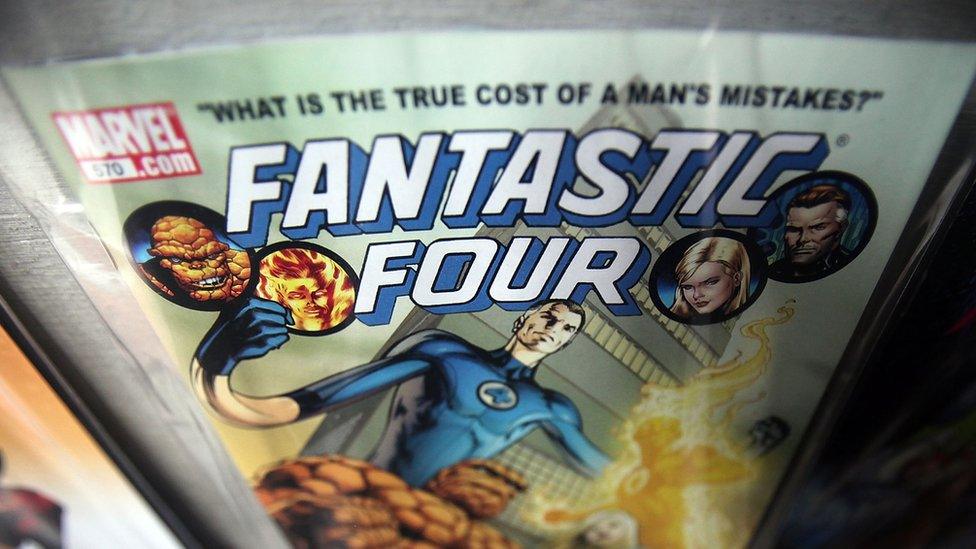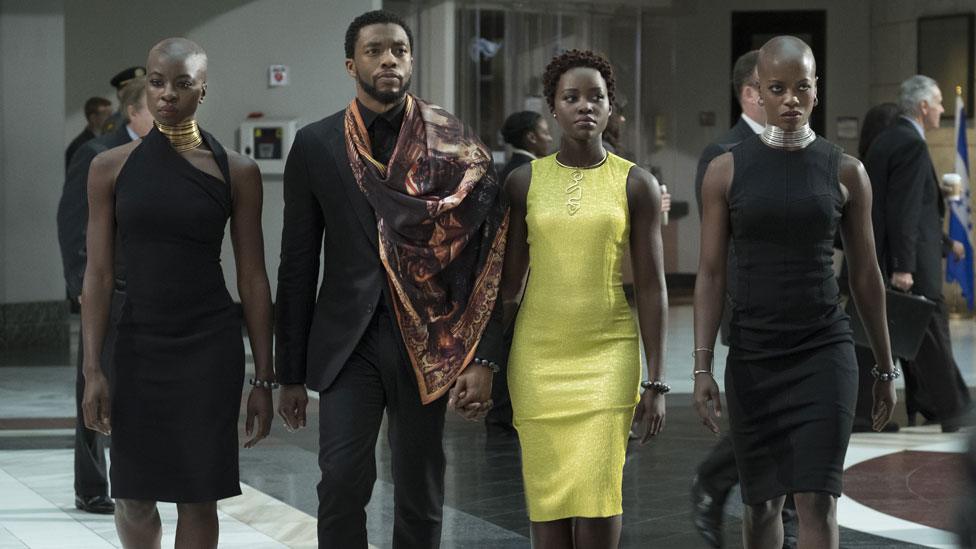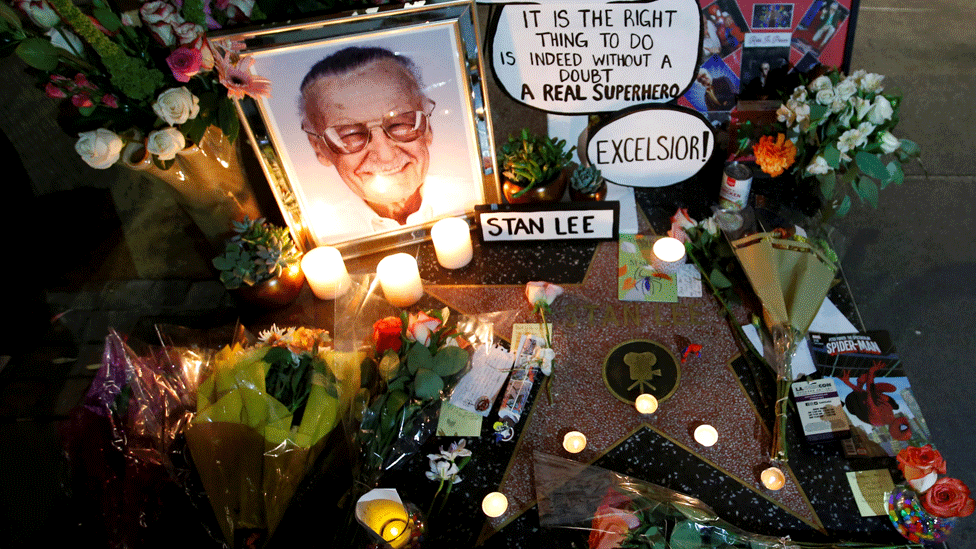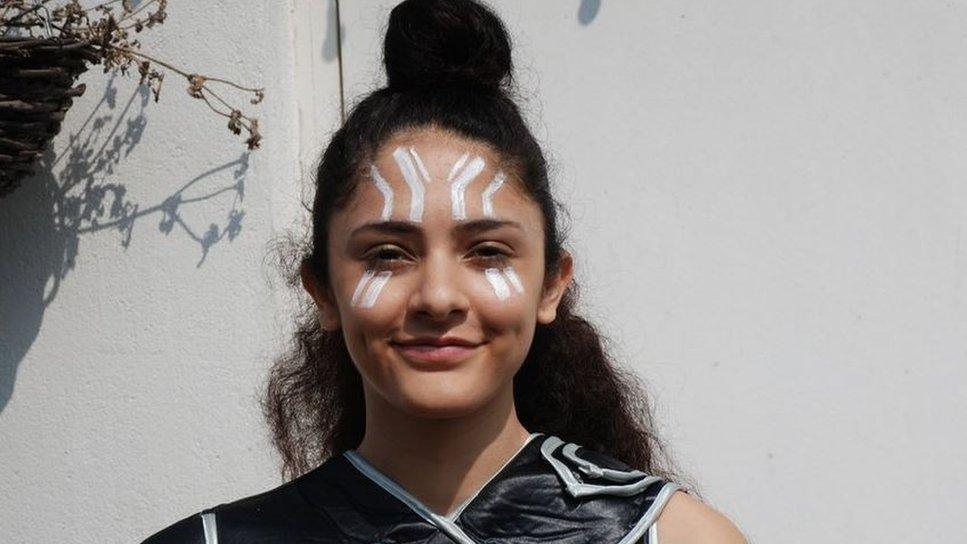How Stan Lee's superheroes helped change the world
- Published

Born Stanley Lieber in 1922, Lee was the former president of Marvel Comics
Through Spider-Man, the X-Men and many other characters, the late Stan Lee sought to make a positive and lasting difference.
It's difficult to envision what pop culture would be like without Stan Lee's prolific impact.
And it's even more difficult to imagine there was a time Lee nearly quit the industry altogether.
After spending more than 20 years working at Timely Comics, which would later evolve into the Marvel we know today, Lee had grown both frustrated and irritated with the public's perception of comic books.
"Nobody, outside of our own little circle, had a good word to say about comic books," Lee said in his 2002 memoir Excelsior.
"To the public at large, comics were at the very bottom of the cultural totem pole."
One day in the early 1960s, as Lee was planning to tell his boss he wanted to quit, he was tasked with creating a new superhero team in the vein of DC's Justice League of America.
After being advised by his wife to experiment with stories he was more passionate about, he put the human in superhuman and started to give his heroes a flawed quality - something to make them more relatable to us mere mortals.

The Fantastic Four revolutionised storytelling within comic books
When jotting down ideas for the Fantastic Four, Lee conceived them as real, living people whose personal relationships would interest readers.
Traditionally, comic books had very simple storylines. Fantastic Four, in contrast, honed in on the personalities of its heroes rather than solely focusing on their abilities.
"They were the kind of team I had been longing to write about," Lee said. "Heroes who were less than perfect.
"Heroes who didn't always get along with each other, but heroes who could be counted on when the chips were down."
The Fantastic Four was published in November 1961 and the public loved the fresh approach, making the new series of books an overnight sensation.
Soon after Lee created the Incredible Hulk and then Spider-Man, which went on to be one of the most successful characters in comic book history.
Allow X content?
This article contains content provided by X. We ask for your permission before anything is loaded, as they may be using cookies and other technologies. You may want to read X’s cookie policy, external and privacy policy, external before accepting. To view this content choose ‘accept and continue’.
Many critics attribute the latter's success to the in-depth characterisation of Peter Parker, as well as his personality quirks.
Peter was the "quintessential hard-luck kid". Despite beating bad guys and protecting the city from danger, he still had trouble finding a date and keeping his acne at bay.
Last summer, when images of the white nationalist rally in Charlottesville circulated on social media, Lee responded with a powerful statement of his own.
"Bigotry and racism are among the deadliest social ills plaguing the world today," he wrote. "As true today as it was in 1968."
The words he shared originally appeared in Stan's Soapbox, a column he wrote for Marvel that was published in the same year Martin Luther King Jr was assassinated.
Allow X content?
This article contains content provided by X. We ask for your permission before anything is loaded, as they may be using cookies and other technologies. You may want to read X’s cookie policy, external and privacy policy, external before accepting. To view this content choose ‘accept and continue’.
While celebrities engaging in politics through social media is seen as a new trend, Lee used his platform to fight prejudice.
From The Fantastic Four to the X-Men, his heroes were outsiders who fight for a better society - no surprise given they were created during the height of the civil rights movement.
X-Men has often been praised for its portrayal of mutant oppression and its reflection of the fight for civil rights. Fans have even compared Professor Xavier and Magneto's differing views to King and Malcolm X's respective ideologies.
"I always felt the X-Men, in a subtle way, often touched upon the subject of racism and inequality," Lee told the Washington Post in 2016, external.
Alongside his long-time collaborator Jack Kirby, Lee also created Black Panther, the first black superhero to appear in comics.
This year's film version was praised for providing the representation many black audiences had been craving for, from children seeing what they could grow up to be, to women witnessing their hair and skin tones being celebrated on screen.
Other fans praised the comic and film for its portrayal of fictional African nation Wakanda as the most technologically advanced country in the world.
Black Panther is now Marvel Studios' most successful release at the box office and has been tipped to win awards at next year's Oscars.

Chadwick Boseman (second from left) with other stars from Black Panther
Through gaming tournaments she organises, Stephanie Nnesaga aims to eradicate the negative, "nerdy" stereotype that is often associated with comics.
The group she founded celebrates gaming, comics and anime and welcomes people from all walks of life to express their passions, without fear of being judged.
"Growing up as a black woman, I often read Marvel comics as an escape," she tells the BBC.
"Whenever I felt down, or wanted to be alone or wanted to get away from the worries of my world, I'd go straight into the comics.
"Stan created this unimaginable world and he inspired me to do what I want and not care what people said about reading comics. He made it cool and inspired me to create my own platform," she continues.
"Like me, Spider-Man was a nerd and wasn't popular. But he was given a chance to be greater at such an young age, and that was so amazing for me to read."
Allow X content?
This article contains content provided by X. We ask for your permission before anything is loaded, as they may be using cookies and other technologies. You may want to read X’s cookie policy, external and privacy policy, external before accepting. To view this content choose ‘accept and continue’.
Stan Lee died on Monday at the age of 95. But his legacy will live on, not least due to the cameo appearances that were a much-loved feature of the films with which he was associated.
It is believed he may have left as many as six different cameos, external in the can before he died - a comforting thought for the many fans for whom he was as much a grandfather as a godfather.

Follow us on Facebook, external, on Twitter @BBCNewsEnts, external, or on Instagram at bbcnewsents, external. If you have a story suggestion email entertainment.news@bbc.co.uk.
- Published13 November 2018

- Published13 November 2018

- Published12 November 2018
